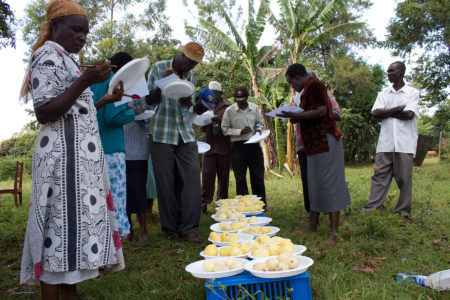
Vivian Polar, Gender, Monitoring and Evaluation Specialist with the CGIAR Research Program on Roots, Tuber and Bananas, shares insights on the importance of considering gender when developing agriculture technology.
Do men and women approach agriculture differently?
Men and women approach agriculture differently. Each one of them looks at farming based on their constraints and their strengths, and the context in which they work. Their technology needs differ from one another.

What do you mean when you say agriculture technology is not gender neutral?
When you say that technology is not gender neutral, you are letting people know that whatever they are designing regarding technology may limit men or women’s access to that technology. For example, you may be designing equipment for harvest or for shredding and what you have in mind is the shredding process, but you haven’t thought of who is going to use that technology. You haven’t thought of how strong or tall that person is or if they will be carrying a baby on their back. Will they be doing this on a small scale for household consumption, or will they be doing this on a large scale? People think of the technology first, in general, that tends to benefit men more than women.
What are the drawbacks of not taking a gender-sensitive approach to technology development?
If you just think about what the technology does or what the variety does, you are thinking of the final product, but you are not thinking of the user. The benefits of a gender-sensitive technology design is that you are more inclusive. You are not just developing a product for a specific use, but for a specific user— this helps to target a particular type of inequality, which in this case, is limited access to technology.
What is something that most people don’t consider about gender when they’re developing new technologies?
One example that comes to mind is a mechanized potato selection tool. It sorted potato by size. It did the job well. As the prototype was developed, the designers overlooked the fact that women were the ones in charge of the selection process. Field trials gathered input from male farmers, and specific adaptions were chosen based on that all male participation. Adaptions were made but were made with the wrong end user in mind. As a result, the female farmers failed to adopt this new selection tool because it was too high for them and required them to lift bags that were too heavy. It was difficult for the women to operate. They wanted something that was manual.
Can you give us an example of how men and women might approach agriculture technology differently?
Many times women are in charge of crops for home consumption, while men will adopt crops for income generation. That specific difference will determine what type of technology men and women will adopt. For example for home consumption, women prefer less labor intensive technology with fewer inputs. Efficiency might not be their top priority, but perhaps the culinary traits might be. In the case of men, when they are targeting a market product of the same crop, they’re going to think about the efficiency and higher yields, and not necessarily other traits.
What would you like others to know about the role of gender in agriculture?
What I would like people to know is that we need not be afraid of addressing gender concerns in agriculture. We need to look at it as an opportunity to increase the uptake of our technology development.
I see so many researchers developing with great care technology products to reduce hunger and to address food insecurity. If we could only enhance that development process to target the other half of the world population, we would increase the adoption of that technology.
What recommendations do you have for other researchers looking at gender in agriculture?
My recommendation is to make it easy and accessible for farmers. I would also like to encourage young female researchers. We need to be part of this development process. A complimentary space of men and women working together will make for better technology products that benefit both male and female farmers.
Vivian Polar is a gender, monitoring and evaluation specialist for the CGIAR Research Program on Roots, Tubers and Bananas
